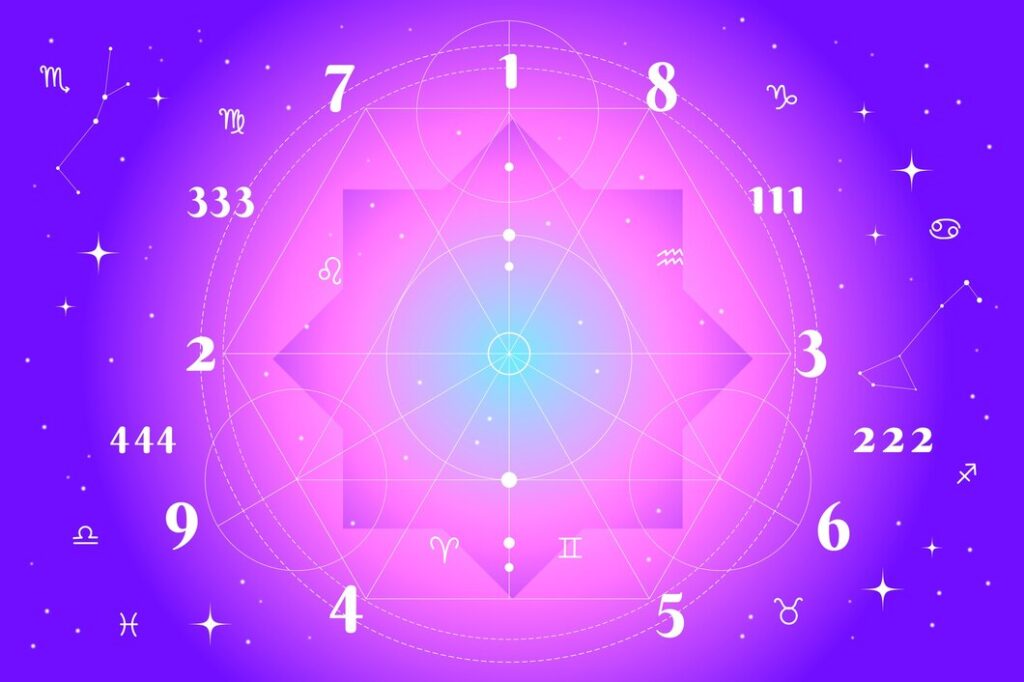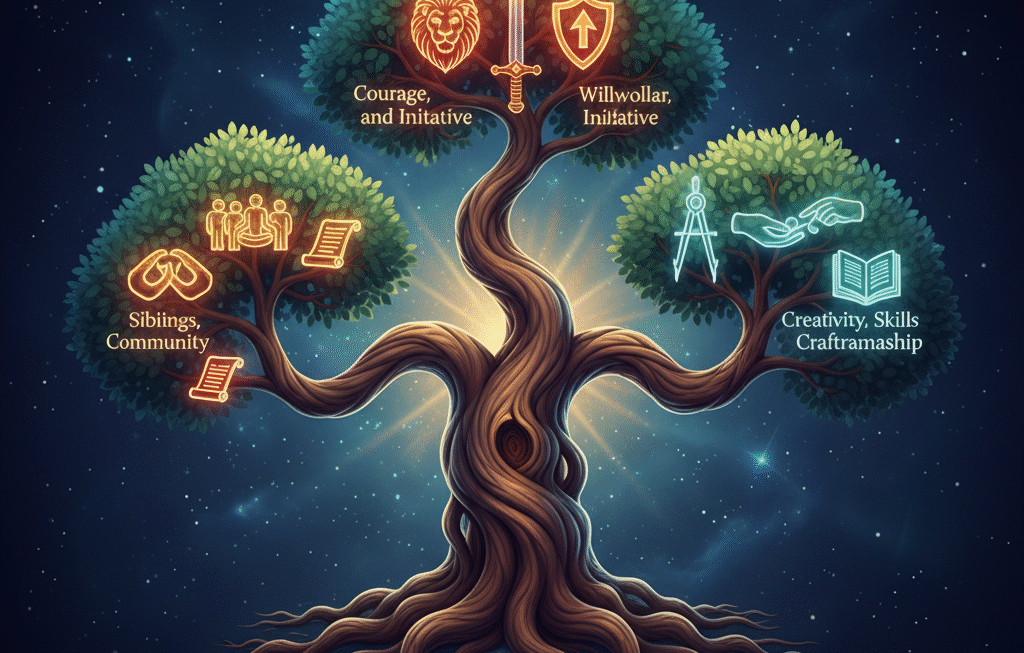What does Vedic astrology reveal about the potential for having children, the nature of one’s relationship with them, and even the unfolding of creative potential? While the 5th house in the main birth chart (Rasi D1) provides the initial overview, a much deeper and more specific understanding requires delving into a particular divisional chart: the Saptamsa chart D7. Understanding the saptamsa chart d7 is crucial for refining predictions related to progeny, grandchildren, and the fruition of creative endeavors. This guide introduces the vital role of the D7 chart in Jyotish, explaining its significance in assessing these profoundly important areas of life.
Astrological Yogas & Vargas: Layers of Karmic Insight
Before focusing on the D7, let’s briefly contextualize its place within Vedic astrological analysis. The Rasi chart (D1) presents the foundational life map, outlining planetary yogas or combinations in astrology that indicate broad life potentials.
However, the Divisional Charts (Vargas) provide essential depth, revealing the underlying quality and specific manifestation of planets concerning different life domains. While the Navamsa (D9) illuminates marriage and dharma, and the Dasamsa (D10) focuses on career, the Saptamsa (D7) specifically zooms in on matters related to children and creative legacy.
What is the Saptamsa Chart (D7)? The Chart of Progeny and Creativity
(Opinion): The Saptamsa Chart (D7) is a crucial Varga chart in Vedic astrology, primarily utilized to analyze matters related to children (progeny), grandchildren, the potential timing and ease of conception, the well-being and nature of one’s offspring, and also aspects of creative potential and the ability to bring creative projects to fruition. It acts as the primary children chart.
(Reason): Why is this specific division linked to these themes? The d7 chart vedic astrology uses is created by dividing each 30-degree zodiac sign into seven equal segments (‘Saptamsas’) of approximately 4 degrees and 17 minutes (4°17′ approx.) each.
The 5th house in the Rasi chart is the primary house governing children (Putra Bhava), intellect (Buddhi), creativity, and past life merit (Purva Punya). The D7 chart, being the 7th harmonic chart, has a mystical resonance with creation and manifestation (7 being a number often associated with subtle creation and partnership needed for it).
It specifically refines and expands upon the 5th house themes related to progeny and the successful manifestation of creative intelligence. By examining planetary placements within this finer division, astrologers can assess the quality, strength, potential timing, and challenges related to having and raising children, as well as the capacity to successfully ‘birth’ creative projects.
(Example): Consider Jupiter, the natural significator (Karaka) for children, placed weakly in the Rasi chart, perhaps suggesting difficulties related to progeny. However, if that same Jupiter is exalted or in its own sign in the Saptamsa chart (D7), it reveals a strong underlying potential for happiness from children, suggesting that difficulties indicated in the Rasi might be overcome, or that the children themselves will be fortunate and bring joy despite initial hurdles.
Conversely, a planet looking strong in the Rasi 5th house might fall into a debilitated sign in the D7, revealing potential hidden problems, health issues for children, or difficulties in the relationship with them, despite the outward promise. The D7 adds crucial detail to d7 children analysis.
(Opinion/Restatement): Therefore, the saptamsa chart d7 is an indispensable tool for refining interpretations related to progeny and creative manifestation. It moves beyond the general indications of the D1 to reveal the specific quality and operational strength concerning these deeply personal areas of life, making progeny analysis much more nuanced.

D7 Children Analysis: Calculation and Interpretive Principles
(Pattern Spotting): How is the Saptamsa chart constructed, and how do we begin the analysis? The calculation involves assigning rulership to the seven segments within each sign.
The Calculation Rule (Parashara Method):
The standard method assigns the seven Saptamsas based on the sign’s quality (Odd/Even):
- For Odd Signs (Aries, Gemini, Leo, Libra, Sagittarius, Aquarius):
- The counting of the Saptamsa lords/signs starts sequentially from the sign itself.
- (0°00′ to 4°17′) -> 1st sign (the sign itself)
- (4°17′ to 8°34′) -> 2nd sign from it
- …and so on up to the 7th segment (25°43′ to 30°00′) -> 7th sign from it.
- For Even Signs (Taurus, Cancer, Virgo, Scorpio, Capricorn, Pisces):
- The counting of the Saptamsa lords/signs starts sequentially from the 7th sign counted from that sign.
- (0°00′ to 4°17′) -> 7th sign from it
- (4°17′ to 8°34′) -> 8th sign from it (or 2nd sign in the next sequence)
- …and so on up to the 7th segment (25°43′ to 30°00′) -> 1st sign (the sign itself, completing the cycle).
(Note: These rules require careful application, best handled by reliable software).
How to Interpret Planetary Placements:
Astrology software calculates the D7 chart based on the precise degree of each planet in the Rasi chart. The analysis then focuses on:
- The D7 Lagna (Ascendant): The sign rising in the Saptamsa chart provides insights into the native’s fundamental creative potential and overall approach/attitude towards children.
- The D7 Lagna Lord: Its strength (dignity) and placement within the D7 chart indicate the overall capacity related to progeny and creative manifestation. Placement in auspicious houses (Kendras/Trikonas) within D7 is favorable.
- The 5th House and Lord in D7: This specifically refines indications for children – their potential number (though complex), well-being, nature, and the native’s relationship with them. Strong benefics here are good; malefics can indicate challenges.
- The 9th House and Lord in D7: Often examined for potential related to grandchildren (being 5th from the 5th).
- Jupiter (Putra Karaka): As the natural significator for children, Jupiter’s dignity, placement, and afflictions within the D7 chart are critically important. A strong Jupiter in D7 is a powerful blessing for matters of progeny.
- Placement of Rasi 5th Lord in D7: Where does the planet ruling the 5th house in your main birth chart (D1) fall within the D7 chart? Its strength and placement in the D7 further qualify matters related to children and creative intelligence.
- Planets in the D7: Benefics (Jupiter, Venus, Moon, Mercury) well-placed generally indicate happiness from children, ease of conception (if relevant), and successful creative endeavors. Malefics (Saturn, Mars, Sun, Rahu, Ketu) can indicate delays, obstacles, health issues for children, difficult relationships, or challenges in bringing creative projects to completion, depending on their strength and placement. Saturn might indicate delay or fewer children. Mars could indicate potential miscarriages or energetic/difficult children. Rahu/Ketu can indicate unusual circumstances or karmic issues related to progeny.
D7 Interpretation: What the Saptamsa Reveals
(Value): Summarizing the key insights gained from the d7 interpretation:
- Potential for Progeny: Likelihood of having children, potential ease or difficulty in conception.
- Nature and Well-being of Children: Insights into the health, character, and potential success of one’s children.
- Relationship with Children: The quality of the bond and interaction between the parent and offspring.
- Timing Related to Children: Used in conjunction with Dashas and transits to refine potential timing for childbirth.
- Potential for Grandchildren: Indications seen via the D7’s 9th house.
- Creative Potential and Fruition: The ability to successfully manifest creative ideas and projects into tangible reality.
- Overall Happiness Derived from Children/Creativity: Assessing the level of joy and fulfillment related to these areas.
Mythbusting: Common Errors in Saptamsa Analysis
(Engagement): The saptamsa chart d7 offers profound insights, but its interpretation requires precision and caution. Here are crucial points and common pitfalls to avoid:
- The Rasi Chart (D1) is Foundational: Always start with the D1. Potential for children must first be clearly indicated in the Rasi chart (e.g., a reasonably strong 5th house/lord, strong Jupiter). The D7 refines this picture; it cannot create potential where none exists in the primary chart. A severely afflicted 5th house/lord or Jupiter in D1 is a major challenge that a good D7 might mitigate but rarely completely overrides.
- Birth Time Accuracy is CRITICAL: The Saptamsa segments are very small (approx. 4°17′). This means the D7 Lagna changes sign roughly every 8 to 9 minutes! Even a small error in birth time can render the entire D7 chart analysis completely inaccurate, especially regarding house placements. Highly accurate, preferably rectified birth time is absolutely essential for reliable D7 analysis. This cannot be stressed enough.
- Predicting Exact Number/Gender: Classical texts provide rules for predicting the number and gender of children based on D7 placements. However, in modern practice, these rules are notoriously unreliable due to complex factors like fertility treatments, adoption, societal changes, individual choices, and karmic complexities not fully captured by simple formulas. Focus the D7 analysis on the potential quality, timing, and well-being related to children, rather than attempting precise counts or gender predictions.
- Holistic Synthesis is Key: The d7 chart vedic astrology uses is just one specific lens. Its indications must be integrated with the D1, the crucial D9 (Navamsa) for overall quality and spouse’s influence, the Karaka (Jupiter), analysis of relevant Yogas, and crucially, the timing shown by the Dasha system. Challenges or blessings related to children primarily manifest during the Dasha periods of the Rasi 5th lord, Jupiter, or planets strongly influencing the D7 chart.
- Distinguishing Children from Creativity: The D7 governs both. Context, the specific planets involved, and the questions being asked help differentiate. Strong Mercury in D7 might favor creative writing, while strong Jupiter might favor having wise children, although overlap is common.
Conclusion: Insights into Creation and Legacy
The Saptamsa Chart (D7) is an indispensable divisional chart in Vedic astrology, offering a focused and deeply insightful perspective on the critical life areas of children, progeny, and creative manifestation. As the primary children chart, it allows for a nuanced d7 interpretation that significantly refines the broader indications concerning the 5th house seen in the main Rasi chart.
By revealing the underlying quality, potential timing, and specific dynamics related to having and raising children, as well as the capacity to successfully ‘birth’ creative projects, the saptamsa chart d7 provides invaluable guidance. However, effective progeny analysis demands acknowledging its sensitivity to birth time accuracy and its place within the larger astrological framework.
It must always be synthesized with the foundational Rasi chart, the crucial Navamsa chart, and the timing of Dasha periods. When used correctly, the D7 chart offers essential keys to understanding the intricate threads connecting us to our children, our creative legacy, and the very act of bringing something new into the world.












